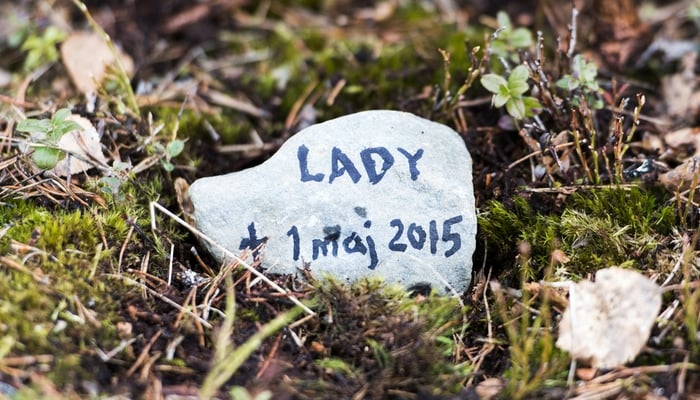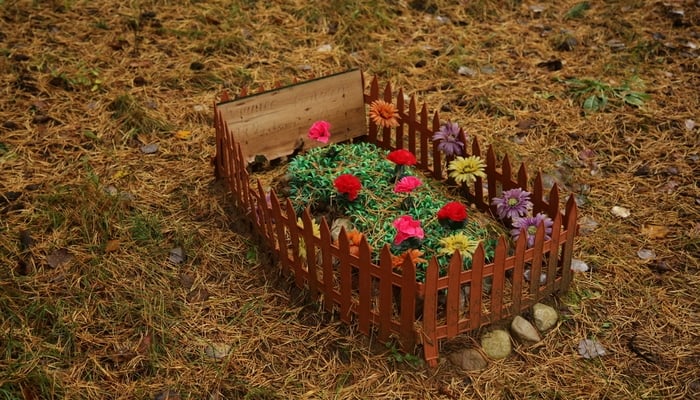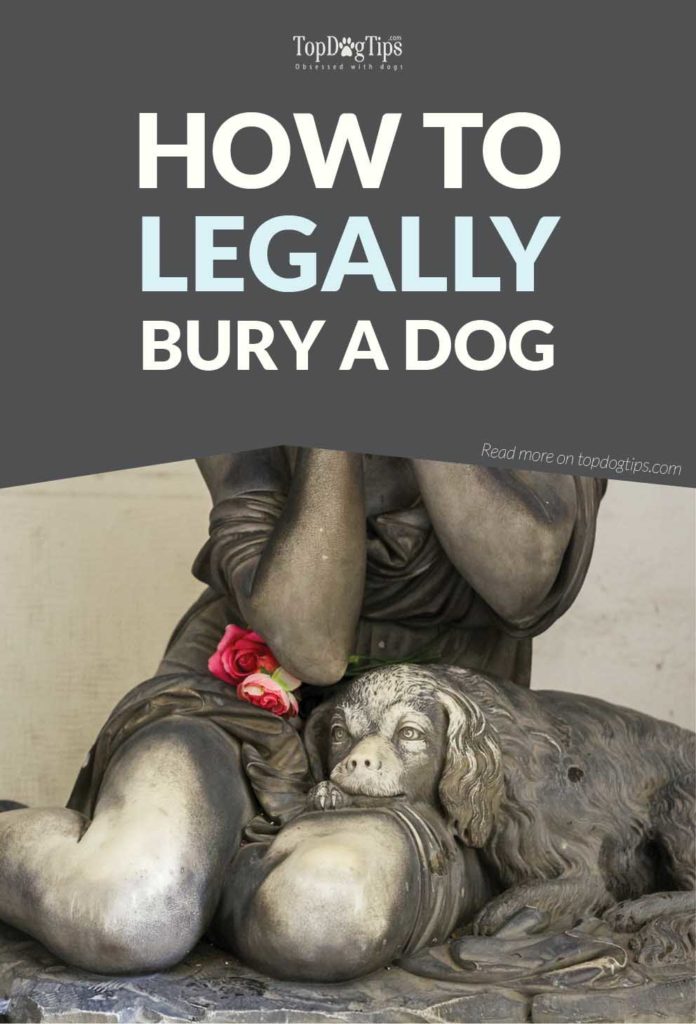
Table of Contents
When a beloved dog passes away, it isn’t uncommon to want to bring their body home and bury them close to where they lived, a place that was home throughout most of their life.
Unfortunately, burying a dog is not that simple, especially in the US. Most importantly, it's not even always legal.
Let's take a look at how to bury a dog legally around where you live and how to ensure that you are following local laws when doing so.
Knowing when to put down your dog and then planning for the burial of a dog is an emotional process, and unless your Fido passes unexpectedly, it's best to make preparations before the time to say goodbye comes.
Having a plan in place on how to bury a pet will make the process less overwhelming and will ensure that your dog gets the proper burial that he certainly deserves.
Needless to say, it's absolutely devastating to lose a pet. As pet owners, we don't want to think about it, but it's better to stay realistic and be prepared well in advance.
The first question I'd like to ask you is this: have you thought about the legal limitations that may affect your pet's burial? And what about the potential health hazards?
The process of burying a dog in itself is not complicated. But what many pet owners don't know is that in the US, there may be laws prohibiting the burial of animals.
However, learning how to bury a dog isn't your only choice, and you can explore other options after your dog passes away. You'll need to do a little bit of research, so you're informed about the choices that you'll have to make.
Keep your budget in mind, and speak with your veterinarian about the different options before you make your choice.
READ MORE: Dog Cremation Guide & How Much It Would Cost
How to Bury a Dog Legally
The Legalities of Dog Burial
When it comes to burying your dog at home or in his or your favorite location, the first and most important thing you need to know is the legal limitations that come into play.
Regulations on pet burial vary from city to city and zoning area to zoning area, so what you need to do is research the very specific area where you want to bury your pet.
For example, if you want to bury your pet in San Antonio, TX, then you should look first into the ordinances of the city of San Antonio.
These ordinances are almost always made available on city government websites under “Animal Ordinances.”
Then, with these city-specific animal ordinances in mind, you need to look into zoning regulations and municipal codes if you want to know how to bury a dog legally.
Zoning regulations and municipal codes are regulations that apply to specific areas of land within a city.
For example, if you live in a house at 123rd Street in San Antonio, Texas, but you want to bury your dog in your favorite spot for him to watch the sunset, you must look at the zoning regulations for that specific location.
For the most part, you will find that the burial of your dog at home is legal (there are exceptions, such as Los Angeles, which forbids the burial of any animal or fowl anywhere other than an established pet cemetery [source, PDF]).
Similarly, the burial of your dog in any non-cemetery or non-home location is typically not legal.
The reason for this is that as your pet's body decomposes, it may pose certain health risks for the community. There's a good answer from Kathy Barros on Quora:
“First, if you are either the owner of the property, or you have the owner's permission to bury your pet, you're halfway there. (If you are a renter and the property owner denies permission and you still proceed with the burial, it could mean eviction or other legal repercussions if you are caught.)
Secondly, you need to check on regulations concerning pet burial. These regulations are generally created due to health and/or environmental concerns. Regulations may approve the burial, but you may have to use an approved material for wrapping the pet's body in (lowering the risk of soil and water contamination) and have the grave at a certain depth – usually, between 3-4 feet deep (less likely to be unearthed, thus protecting humans and other animals from disease).”
So make sure you do the research and follow the laws, and you'll be alright.
RECOMMENDED: 15 Ways To Spend Last Days with Your Dying Dog
Health Hazards of Burying a Dog
Speaking of potential risks when burying a dog, even when your pet burial plans are legal, you must still consider all the health hazards that burial may present to the local community.
These dangers are often the reason for pet burial at home sites being illegal, but even when legal, this should be heeded when thinking about how to bury a dog.
Some important considerations include:
- Whether or not your dog’s remains are biohazardous – did your pet have a disease that could pose a hazard if he is buried? If so, DO NOT consider a burial at home.
- Whether your burial location is near a water source – If you bury your pet close to a water source, it is possible that his remains could contaminate that source. DO NOT bury your pet close to rivers, lakes, streams, etc.
- Whether you can bury your pet deep enough in the ground – If you cannot dig deep enough due to gas lines, ground consistency, strength, etc, DO NOT bury your pet in this location.
These health hazards are the reason we have laws about burying animals and fowl, and you can read more about this on FindLaw.com—some very useful information here.
What You Need to Bury Your Dog
 When you have ascertained that it is legal to bury your dog in your backyard according to your local and state laws, it's time for you to prepare yourself with the necessary supplies.
When you have ascertained that it is legal to bury your dog in your backyard according to your local and state laws, it's time for you to prepare yourself with the necessary supplies.
There are several ways to go about this and each approach has different costs.
Things you may need to bury a dog include:
- A biodegradable burial “container.”
- A shovel.
- Any favorite toys to be buried with your dog.
- A grave marker if desired.
Please note that a biodegradable pet casket is best for the environment and can be purchased from a vet clinic, pet crematorium, or online.
Some people utilize a cardboard box in a pinch if their region does not require an approved pet casket to be used.
However, if you want to do the least damage to the environment and your community, consider a pet casket that ticks all the environment-friendly checkboxes.
The same applies to other things, such as a pet memorial stone.
If you're burying a dog in your backyard, you'll want something to remember him by, but also ensure not to do any damage to the surroundings or your future pets that will be around.
RELATED: The Rainbow Bridge – What to Do When Your Dog Dies
How to Bury A Dog – The Process
When you are ready to bury your dog, the first thing you want to do is find a location for the grave site.
Pick a place away from any gas lines, water lines, and other hazards so that you will be unhindered in your digging and don't strike any cables, wires, etc.
Using your best judgment, be sure to select a location that will not be excavated in the future, for example, to plant a flowerbed.
Lastly, pick an area that will not flood due to rain, sprinkler system accidents, septic tank problems, or any other reasons.
Once you have chosen your grave site, begin digging your dog’s final resting place. The hole should be slightly larger in width and length than the burial container or pet casket you have selected.
You want to dig a minimum of 4 feet deep to ensure that your dog will remain in his resting place without being bothered by other animals.
When you have finished digging the grave for your dog’s remains, have someone help you place your beloved pet inside his burial container or dog casket, along with any favorite toys you wish to bury with him.
Then, put the lid on your dog’s burial container and have someone help you carefully place the container inside the grave.
With your dog’s remains in the grave that you dug, take the chance to say the last few words to remember your pet or simply to reflect.
This is a time of great difficulty, emotion, and stress for a pet owner, so take however much time you need to celebrate the life that your dog had with you.
When you are ready, carefully begin to place the dirt you dug out back into the grave. Be careful when placing the dirt on top of your dog’s burial container, and place it just a little at a time using your shovel.
You will notice that as you begin to fill in the grave site, you have more dirt that will go back into the grave.
When the grave is completely filled in, you can place the remaining dirt in a nearby flowerbed or compost heap or just spread it around.
When you have filled your dog’s grave in completely, you may want to place a grave marker or a pet memorial to remember the site.
Many people feel that a grave marker is a headstone or cross; however, you can mark your dog’s grave any way you see fit. Other grave marker options include decorative rocks, statues, or plaques.
You may even want to place a bench beside your dog’s final resting place so that you might sit with him when you feel the need to.
How you choose to memorialize your pet’s grave site is up to you and you alone, as long as you don't break any laws.
















